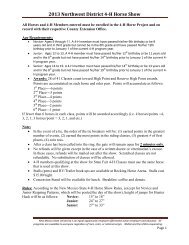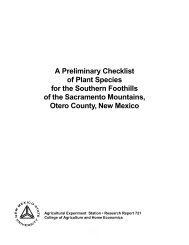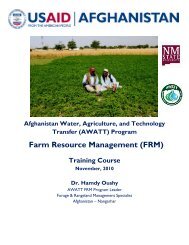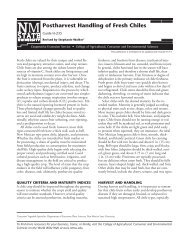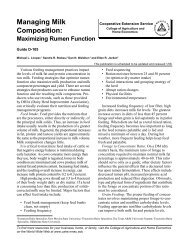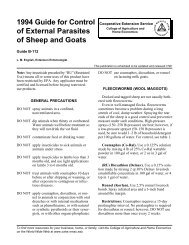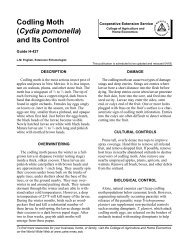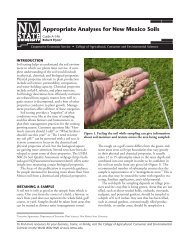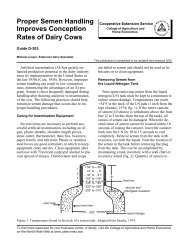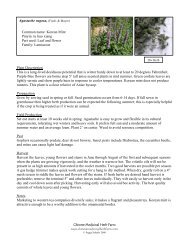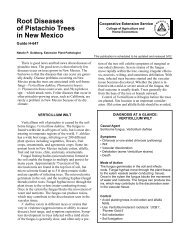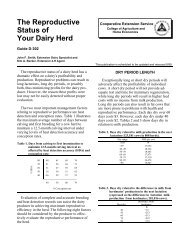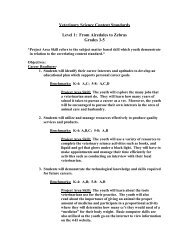Pruning Mature Pecan Trees - New Mexico State University
Pruning Mature Pecan Trees - New Mexico State University
Pruning Mature Pecan Trees - New Mexico State University
You also want an ePaper? Increase the reach of your titles
YUMPU automatically turns print PDFs into web optimized ePapers that Google loves.
<strong>Pruning</strong><strong>Mature</strong> <strong>Pecan</strong> <strong>Trees</strong>Cooperative Extension ServiceCollege of Agriculture andHome EconomicsN EW MEXU NICOSTAEI V E R SI T YTGuide H-629 • PH 4-610Esteban Herrera, Extension Horticulturist, <strong>New</strong> <strong>Mexico</strong> <strong>State</strong> <strong>University</strong>John M. White, County Extension AgentThis publication is scheduled to be updated and reissued 2/05.From the time the tree comes into economic production,it is a mature tree. There is another group of pruningoperations that can help the producer increase ormaintain yields and improve nut quality. The other pruningpractices are usually accomplished during the trainingand establishment stage of orchard development.<strong>Mature</strong> trees are pruned to decrease shading, to removebad limb angles, to remove dead limbs, and toremove lower branches to accommodate orchardequipment. Some of the hedging practices include:Mechanical HedgingThis pruning technique has received much discussionin the past 15 years. Some of the things we knowabout it are:(a) It should be done before the trees go out of productionor have a chronic low nut quality problem. Annualrecords should be kept to learn when nut quantityand quality in pecan orchards are decreasing.(b) It can be done economically.(c) It increases yields and improves nut quality for ashort period of time.(d) Hedging is a temporary treatment and must bedone again after three or four seasons, dependingon the pruning system selected.(e) Yield increases from hedging may be smaller witheach successive hedging operation.(f) Annual light prunings are recommended overheavy prunings (but only branches 1” to 1 1 /2” indiameter).(g) Light mechanical pruning is also recommened thewinter just before the season when a heavy crop isanticipated.Thinning or Complete Tree RemovalAfter three or four hedging treatments, benefits arereduced to a point where hedging may not be beneficial.The roots start to compete for moisture andnutrients and the trees will shade each other. The onlyeconomical treatment is to remove trees. This practicehas been adopted in ultra-high-density and highdensityorchards, but growers have been slow in decidingto remove trees after the stand has been expandedover the 30' ✕ 30' or 35' ✕ 35' spacing.The removal of trees from 30' ✕ 30' spacing is acontinuation of the sequence where the space has progressedfrom 15' ✕ 30' to 30' ✕ 30'. The first step is toremove 25% of the trees by taking out every othertree in every other row. This will give an immediateincrease in nut quality and, by the second season afterthinning, yields will increase. When the trees start tocrowd at this spacing, more trees should be removed,to take out every other tree in the remaing rows leavingtree spacing at about 42' ✕ 42'. This thinningtreatment should be increased to 60' ✕ 60' in a fewyears, which will probably be the final spacing for thelife of the orchard.<strong>Mature</strong> Tree Cut BackIn instances where trees were planted too close andwere allowed to grow together and crowd, growersmay try to correct the situation by cutting the treesback severely. This is commonly called dehorning orpollarding. This pruning process is not effective inbringing the trees back into full production. Part of a50-year orchard in <strong>Mexico</strong> was pruned this way andthe rest was pruned by tree removal. Under the treeremoval system, the orchard was in full production inonly 1 year. The trees that were dehorned were not inproduction 5 years after the dehorning process. Asimilar demonstration was conducted on a 60-year-oldStuart pecan orchard in Texas. <strong>Trees</strong> were severely
dehorned or moderately dehorned. The severely dehornedtrees have not produced pecans after 3 years.Corrective <strong>Pruning</strong>A certain amount of corrective pruning must be doneeach year to maintain tree health and to accommodateorchard equipment. Narrow crotches should beremoved. Complete branches should be routinelyeliminated in the center of the tree to improve sunlightpenetration. Branches that are getting in each other’sway should also be eliminated routinely to preventlimb shading. Cuts should be made to the nearestcrotch to prevent regrowth of suckers. This processwill delay orchard crowding but, eventually, it will benecessary to thin the orchard or start mechanicalhedging.Lower scaffold limbs that prevent clamping of thetree shaker during harvest must be removed. Limbsthat are low enough, because of the tree’s heavy crop,that tractor wheels will run over or damage themshould be removed. Dead wood can be removed, butmost producers just shake it out during harvest. Thoseorchards that have been hedged a couple of times usuallyhave a large amount of dead limbs.One of the most expensive parts of any pruningoperation, whether the orchard is being hedged ortrees are being removed, is the removal of prunings.There are as many methods of removing the brush afterpruning as there are orchards. Each producer willwork out a procedure that fits his situation, labor force,and available equipment. Some firewood can be sold,which might offset some of the brush removal cost.Summary<strong>Pruning</strong> mature trees is expensive but necessary.Most pruning operations that are done to maintain treesize and to reduce shading.Growers shouldcoordinate these pruning operations with the periodicremoval of trees to maximize production and maintainquality. Annual light mechanical prunings may be theanswer to large orchard operations. If done routinelyremoved branches will be no thicker than 1” to 1 1 / 2”in diameter.<strong>New</strong> <strong>Mexico</strong> <strong>State</strong> <strong>University</strong> is an equal opportunity/affirmative action employer and educator. NMSU and the U.S. Department of Agriculturecooperating.Revised February 2000Las Cruces, NM5CGuide H-629 • Page 2



